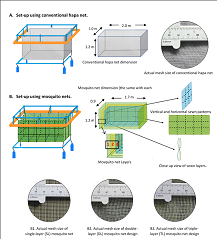Can commercially available mosquito nets be used for rearing sandfish (Holothuria scabra) juveniles in floating ocean nursery?
DOI:
https://doi.org/10.47193/mafis.3622023010504Keywords:
ocean nursery, post-settled sandfish, growth, survival, PhilippinesAbstract
This study investigates the potential of locally available mosquito nets as an alternative material for sandfish ocean nurseries. Mosquito nets (~ 2 mm mesh) were designed into single (SL), double (DL), and triple-layered (TL) to approximate the conventional hapa (CH) with ~ 1 mm mesh normally used in sandfish ocean nurseries. The study was conducted in Maliwaliw island and in a cove in Buyayawon both located in Eastern Samar, Philippines. Results showed that TL had the highest juvenile survival (35.93 ± 10.56%) in Maliwaliw, which was significantly different (p < 0.05) from SL and DL. The DL design showed the highest survival (25.23 ± 17.15%) in Buyayawon by day 60, followed by TL (21.37 ± 3.11%), although not statistically significant. On the other hand, average growth rate was highest in SL in both sites where survival was also the lowest. Biomass, however, was the highest in DL in Buyayawon (1,014 ± 266 g m-2) followed by TL in Maliwaliw (925 ± 107 g m-2). Sandfish juvenile survival in DL and TL were higher than those in the CH in both sites suggesting that mosquito nets can indeed be used as an alternative material for rearing early-stage sandfish juveniles in floating ocean nurseries.
Downloads
References
Agudo N. 2006. Sandfish hatchery techniques. Noumea: Australian Centre for International Agricultural Research, Secretariat of the Pacific Community and, WorldFish Center. 44 p.
Altamirano JP, Noran-Baylon RD. 2020. Nursery culture of sandfish Holothuria scabra in sea-based floating hapa nets: effects of initial stocking density, size grading, and net replacement. Aquaculture. 526: 735379. DOI: https://doi.org/10.1016/j.aquaculture.2020.735379
Altamirano JP, Sinsona MJ, Caasi OJC, de la Torre-de la Cruz M, Uy WH, Noran-Baylon R, Juinio-Meñez MA. 2021. Factors affecting the spatio-temporal variability in the production of sandfish Holothuria scabra juveniles in floating hapa ocean nursery systems. Aquaculture. 541: 736743. DOI: https://doi.org/10.1016/j.aquaculture.2021.736743
Bowman WM. 2012. Sandfish production and development of sea ranching in northern Australia. In: Hair CA, Pickering TD, Mills DJ, editors. Asia-Pacific tropical sea cucumber aquaculture, Proceedings of an international symposium held in Noumea, New Caledonia, 15-17 February 2011. ACIAR Proceedings No. 136. Canberra: Australian Centre for International Agricultural Research. p. 75-78.
Cabacaba NS, Campo CJM. 2019. First-phase juvenile rearing of the sea cucumber Holothuria scabra in Eastern Samar, Philippines. Philippine J Fish. 26 (2): 72-81. DOI: https://doi.org/10.31398/tpjf/26.2.2019A0009
Gamboa RU, Aurelio RM, Ganad DA, Conception LB, Abreo NAS. 2012. Ocean nursery systems for scaling up juvenile sandfish (Holothuria scabra) production: ensuring opportunities for small fishers. In: Hair CA, Pickering TD, Mills DJ, editors. Asia-Pacific tropical sea cucumber aquaculture. Proceedings of an international symposium held in Noumea, New Caledonia, 15-17 February 2011. ACIAR Proceedings No. 136. Canberra: Australian Centre for International Agricultural Research. p. 63-74.
Gorospe JR, Juinio-Meñez MA, Southgate PC. 2019. Effects of shading on periphyton characteristics and performance of sandfish, Holothuria scabra Jaeger 1833 juveniles. Aquaculture. 512: 734307. DOI: https://doi.org./10.1016/j.aquaculture.2019.734307
Juinio-Meñez MA, de Peralta GM, Dumalan RJP, Edullantes CMA, Catbagan TO. 2012. Ocean nursery systems for scaling up juvenile sandfish (Holothuria scabra) production: ensuring opportunities for small fishers. In: Hair CA, Pickering TD, Mills DJ, editors. Asia-Pacific tropical sea cucumber aquaculture. Proceedings of an international symposium held in Noumea, New Caledonia, 15-17 February 2011. ACIAR Proceedings No. 136. Canberra: Australian Centre for International Agricultural Research. p. 57-62.
Magcanta ML, Sornito MB, Espadero AD, Bacosa HP, Uy WH. 2021. Growth, survival, and behavior of early juvenile sandfish Holothuria scabra (Jaeger, 1883) in response to feed types and salinity levels under laboratory conditions. Philippine J Sci. 150 (5): 901-913.
Mills DJ, Duy NDG, Juinio-Meñez MA, Raison CM, Zarate JM. 2012. Overview of sea cucumber aquaculture and sea-ranching research in the South-East Asian region. In: Hair CA, Pickering TD, Mills DJ, editors. Asia-Pacific tropical sea cucumber aquaculture. Proceedings of an international symposium held in Noumea, New Caledonia, 15-17 February 2011. ACIAR Proceedings No. 136. Canberra: Australian Centre for International Agricultural Research. p. 22-31.
Sinsona MJ, Juinio-Meñez MA. 2019. Periphyton characteristics influence the growth and survival of Holothuria scabra early juveniles in an ocean nursery system. Aquacult Res. 50 (9): 2655-2665. DOI: https://doi.org/10.1111/are.14223
Pitt R, Duy NDQ. 2004. Breeding and rearing of the sea cucumber Holothuria scabra in Viet Nam. In: Lovatelli A, Conand C, Purcell S, Uthicke S, Hamel JF, Mercier A, editors. Advances in sea cucumber aquaculture and management. FAO Fish Tech Pap. 463: 333-346.
Purcell SW, Agudo NS. 2013. Optimisation of mesh enclosures for nursery rearing of juvenile sea cucumbers. PLoS ONE. 8 (5): e64103. DOI: https://doi.org/10.1371/journal.pone.0064103

Published
Issue
Section
License
Copyright (c) 2023 Margarita de la Torre-de la Cruz, Jonh Rey L. Gacura, Racelle R. Rescordado, Janine L. Villamor

This work is licensed under a Creative Commons Attribution-NonCommercial-ShareAlike 4.0 International License.
Authors of articles published in Marine and Fishery Sciences retain copyright on their articles, except for any third-party images and other materials added by Marine and Fishery Sciences, which are subject to copyright of their respective owners. Authors are therefore free to disseminate and re-publish their articles, subject to any requirements of third-party copyright owners and subject to the original publication being fully cited. Visitors may also download and forward articles subject to the citation requirements. The ability to copy, download, forward or otherwise distribute any materials is always subject to any copyright notices displayed. Copyright notices must be displayed prominently and may not be obliterated, deleted or hidden, totally or partially.
This journal offers authors an Open Access policy. Users are allowed to read, download, copy, distribute, print, search, or link to the full texts of the articles, or use them for any other legal purpose within the Creative Commons 4.0 license (BY-NC-SA), without asking prior permission from the publisher or the author. This is in accordance with the BOAI definition of Open Access.




























